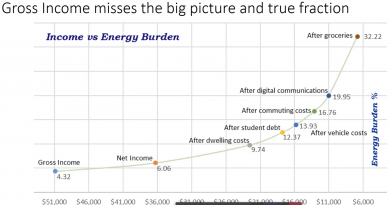Sidebar: An Easy Argument Against Fossil Fuels? Cost.
In an accompanying article about the proliferation of utility-scale solar farms, I mentioned how solar is becoming popular not because of a giant conspiracy led by George Sorrows And Hillary Clinton’s E-mails [sic], but rather because of how cheap it is. I wanted to look at the question of how cheap, though, and specifically, I wanted to see how solar stacked up against fossil fuels. It was interesting to compare data from different sources, which suggest that solar’s levelized cost of electricity (LCOE) actually turns out to be far cheaper than competitors that, we are told time and again by fossil fuel interests, are the only way to deliver reliable energy to the power grid. For the Rob Bradley types reading this, that doesn’t mean that photovoltaics will solve all of our problems. It just means that it’s now factually incorrect to say that solar power is more expensive than coal or fossil gas.
The LCOE is calculated by the below equation (lifted straight from Wikipedia, sorry not sorry):

This is giving us a way to compare different power sources based on the averaged cost over time, accounting both for not only the marginal cost of production but also the cost of installation, lifespan, maintenance, fuel costs, etc. It should surprise no one that solar power and wind were uneconomical compared to fossil fuels ten or fifteen years ago, but are now the most economical sources of power. Also? Turns out we’ve been drastically underestimating the costs of most sources of power, something that has evolved over the past decade.

The cost-effectiveness of nuclear– whose fuel cost is pretty darn close to zero, owing to the enormous thermal productivity of the process of splitting the uranium atom- is hampered by the huge cost of building a massive baseload generating plant (with basically half-century old technology, which may make for another fun article!). It’s possible that this will change or evolve to some degree, especially with the advent of new reactor technology. While we keep hearing more and more about SMRs and all manner of other new nuclear technology, none have actually been built for commercial operation as of the time of writing this, and it seems unlikely that this will happen in the next few years, absent a huge push wielding both regulatory power and popular opinion. I’m cautiously optimistic about novel nuclear technology, but again, let’s stick to renewables for the purpose of this article.

According to the EIA’s data from 2021, the LCOE of these different costs are as follows, descending from highest-cost to lowest:
Solar (thermal): $133/MWh. Solar thermal systems here are referring to utility-scale plants that collect a lot of light to heat up something in order to produce steam to convert into electricity. One study estimated an LCOE for solar thermal that was 23% cheaper per MWh than fossil gas electricity.
Nuclear: $88/MWh. Again, nuclear outperforms any other fuel-dependent power source when it’s measured in terms of dollars of fuel cost per megawatt of power output. But it’s really, really expensive to build nuclear plants! This number reflects that, and shouldn’t necessarily be used to consider the question of whether to keep older nuclear plants operating.
Coal: $83/MWh. Coal is a reliable baseload energy source, but it produces enormous carbon emissions, to say nothing of the staggering amounts of toxic waste that often flood waterways.
Fossil Gas: $40/MWh. Why is fossil gas so cheap? The explosive– no pun intended- growth of the power source in the 2000s and 2010s was, as mentioned, a product of replacing coal-fired power plants while at the same time the gas industry had discovered the bounty of Marcellus Shale (the stuff that makes it so your tap water is flammable). The LCOE doesn’t include the externalities of fossil fuel extraction or combustion, though, which cost the global economy trillions of dollars. So, there’s that. Also, note in the below chart that the projected LCOE increases a bit for natural gas through 2050, while the estimated cost of solar PV declines modestly.
Wind. $38/MWh. Cheaper than gas, you say?! It was interesting to note that offshore wind is actually far more expensive according to that same EIA report. Offshore wind– which is quite new in the United States and accounts for only a tiny share of the present generation mix- will come down quite a bit in cost because it is easier to scale quickly. Benefits of this setup versus land-based wind is that there is usually a more steady rate of wind offshore than onshore, and offshore wind can be sited closer to major load centers (i.e. Lake Michigan or the Atlantic coastlines anywhere from New Jersey the whole way up to Boston, basically, as opposed to Iowa or West Texas, whose wind power is dependent upon expensive high-voltage transmission to get it to bigger cities).
Photovoltaics (solar panels): $36/MWh. Solar prices have been declining for years as a product of increased efficiencies, better manufacturing and better material science, and economies of scale in production. It’s not a perfect technology, by any means: production of solar panels requires an enormous amount of resources including rare earth metals. No one’s really figured out exactly how long solar panels last, or what to do with them once they’ve reached the end of their useful life. But at this point, barring massive load reductions, solar power is certainly preferable as a zero-carbon power source that relies on a power source that is going to be around at least for a few billion more years (from which energy can be produced without detriment to the local environment).

So, we now see that solar panels are (in 2021 dollars) the cheapest option by quite a bit.
The problem now is that the sun does not shine everywhere 24 hours a day, which means that we must have some sort of battery storage, pumped storage hydro, or perhaps a Faustian deal to create a thermodynamically impossible system to be able to store more heat overnight. Funny we should mention this last one: that’s how most solar thermal systems work, at least to some degree– they heat a medium that can be used to turn water into steam, and this medium typically holds quite a bit of heat even after the sun sets. Fernandes and Schaefer (cited earlier) come up with a cost of $132.90/MWh for solar thermal, which is even higher than the $128.55 LCOE for battery storage. NREL suggests that battery storage costs could well be higher than that, but also notes that they’re declining. The experience curve of that declining cost also doesn’t take into account novel battery technology that will (at some point) bust onto the scene.

I don’t want to get irrationally exuberant about this because we’ve been hearing about novel battery chemistry for a decade now without any commercialized versions to challenge King Lithium. But it will happen at some point.
Again, though, when we’re talking about comparisons of renewables and not-renewables, that solar is even close to gas, let alone substantially cheaper, should make any renewable energy skeptic think a bit about what that all means. It means that the market has– with frankly pretty minimal public subsidy, considering how many trillions are pumped into the fossil fuel industry each year- already adapted to the new paradigm, and is getting us ever closer toward a zero-carbon goal. As a guy I used to work with once said, “now, I think I am pretty smart! But I’m not as smart as Mr. Market!”
Clearly, we have a ways to go. I suspect that battery systems will become popular to increase local feeder resiliency rather than to provide an option for, say, higher-voltage power transmission. In other words, I’d expect way more in residential and commercial battery storage systems than I would expect in huge utility-scale systems, and even then, I’d expect to see these more at a local level on a smaller scale rather than a massive scale given the high cost. That cost will come down, certainly, but it’s never going to be enough to say that “this one technology will solve all of our problems.”
Indeed, storage solutions, whether we’re talking about solar thermal or batteries, don’t need to equate to 100% of the renewable mix– they just need to provide buffers for extreme demand and to balance out the parts of the so-called duck graph, chiefly in the peak evening hours as the sun is setting and the wind hasn’t picked up yet but demand is high. This involves supplementing those other power sources for a few hours, but it doesn’t mean that the $138/MWh LCOE of battery storage is going to translate to an LCOE of 13.8 cents per kilowatt hour for all power, period. That cost will be lowered by cheap renewables. The other thing to mention here is that EIA’s estimates of distributed solar adoption seem problematically low to me. That’s something that I mentioned in the other article as I’d love to see more of an emphasis on smaller-scale distributed generation, which can come from local and state levels (while the EIA is mostly focused on big picture).
The key here is that the fossil paradigm is, slowly but surely, coming to a close, and the market– per the plunging LCOE of solar- is already figuring out what that is going to mean for the generation mix of tomorrow. Certainly, it’s not going to be much more expensive– as long as we are combining electrification with reductions in primary demand (a little thing called efficiency). There are obviously a number of complicated factors, but it’s encouraging that we can at least now make the argument that green (in terms of energy) translates to more green in the form of savings.


